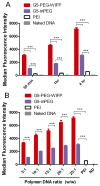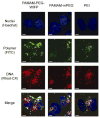Intracellular trafficking of polyamidoamine-poly(ethylene glycol) block copolymers in DNA delivery
- PMID: 21761838
- PMCID: PMC3218102
- DOI: 10.1021/bc200059v
Intracellular trafficking of polyamidoamine-poly(ethylene glycol) block copolymers in DNA delivery
Abstract
The delivery of nucleic acids has the potential to revolutionize medicine by allowing previously untreatable diseases to be clinically addressed. Viral delivery systems have shown immunogenicity and toxicity dangers, but synthetic vectors have lagged in transfection efficiency. Previously, we developed a modular, linear-dendritic block copolymer architecture with high gene transfection efficiency compared to commercial standards. This rationally designed system makes use of a cationic dendritic block to condense the anionic DNA and forms complexes with favorable endosomal escape properties. The linear block provides biocompatibility and protection from serum proteins, and can be functionalized with a targeting ligand. In this work, we quantitate performance of this system with respect to intracellular barriers to gene delivery using both high-throughput and traditional approaches. An image-based, high-throughput assay for endosomal escape is described and applied to the block copolymer system. Nuclear entry is demonstrated to be the most significant barrier to more efficient delivery and will be addressed in future versions of the system.
Figures





Similar articles
-
Polyplex micelles from triblock copolymers composed of tandemly aligned segments with biocompatible, endosomal escaping, and DNA-condensing functions for systemic gene delivery to pancreatic tumor tissue.Pharm Res. 2008 Dec;25(12):2924-36. doi: 10.1007/s11095-008-9720-2. Epub 2008 Sep 10. Pharm Res. 2008. PMID: 18781378
-
Engineering biodegradable micelles of polyethylenimine-based amphiphilic block copolymers for efficient DNA and siRNA delivery.J Control Release. 2016 Nov 28;242:71-79. doi: 10.1016/j.jconrel.2016.08.004. Epub 2016 Aug 4. J Control Release. 2016. PMID: 27498020
-
Divalent folate modification on PEG: an effective strategy for improving the cellular uptake and targetability of PEGylated polyamidoamine-polyethylenimine copolymer.Mol Pharm. 2015 Jan 5;12(1):240-52. doi: 10.1021/mp500572v. Epub 2014 Dec 16. Mol Pharm. 2015. PMID: 25514347
-
Block and graft copolymers and NanoGel copolymer networks for DNA delivery into cell.J Drug Target. 2000;8(2):91-105. doi: 10.3109/10611860008996855. J Drug Target. 2000. PMID: 10852341 Review.
-
Polymers for nucleic acid transfer-an overview.Adv Genet. 2014;88:231-61. doi: 10.1016/B978-0-12-800148-6.00008-0. Adv Genet. 2014. PMID: 25409608 Review.
Cited by
-
Peptide dendrimer/lipid hybrid systems are efficient DNA transfection reagents: structure--activity relationships highlight the role of charge distribution across dendrimer generations.ACS Nano. 2013 May 28;7(5):4668-82. doi: 10.1021/nn400343z. Epub 2013 May 17. ACS Nano. 2013. PMID: 23682947 Free PMC article.
-
Acute and chronic shear stress differently regulate endothelial internalization of nanocarriers targeted to platelet-endothelial cell adhesion molecule-1.ACS Nano. 2012 Oct 23;6(10):8824-36. doi: 10.1021/nn302687n. Epub 2012 Sep 14. ACS Nano. 2012. PMID: 22957767 Free PMC article.
-
Getting across the cell membrane: an overview for small molecules, peptides, and proteins.Methods Mol Biol. 2015;1266:29-53. doi: 10.1007/978-1-4939-2272-7_3. Methods Mol Biol. 2015. PMID: 25560066 Free PMC article. Review.
-
Enhanced bioactivity of internally functionalized cationic dendrimers with PEG cores.Biomacromolecules. 2012 Dec 10;13(12):4089-97. doi: 10.1021/bm301384y. Epub 2012 Nov 27. Biomacromolecules. 2012. PMID: 23140570 Free PMC article.
-
Crosslinked linear polyethylenimine enhances delivery of DNA to the cytoplasm.J Control Release. 2013 Apr 10;167(1):101-7. doi: 10.1016/j.jconrel.2012.09.004. Epub 2012 Sep 18. J Control Release. 2013. PMID: 22995755 Free PMC article.
References
-
- Somia N, Verma IM. Gene therapy: trials and tribulations. Nat Rev Genet. 2000;1:91–99. - PubMed
-
- Schaffert D, Wagner E. Gene therapy progress and prospects: synthetic polymer-based systems. Gene therapy. 2008;15:1131–8. - PubMed
-
- Walther W, Stein U. Viral vectors for gene transfer - A review of their use in the treatment of human diseases. Drugs. 2000;60:249–271. - PubMed
-
- Zaiss AK, Muruve DA. Immunity to adeno-associated virus vectors in animals and humans: a continued challenge. Gene Ther. 2008;15:808–816. - PubMed
Publication types
MeSH terms
Substances
Grants and funding
LinkOut - more resources
Full Text Sources
Other Literature Sources

